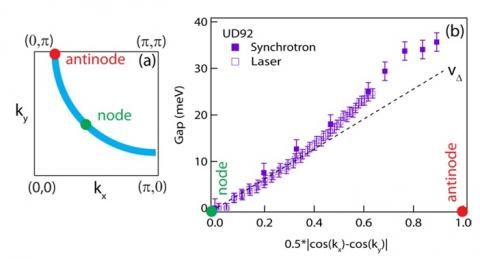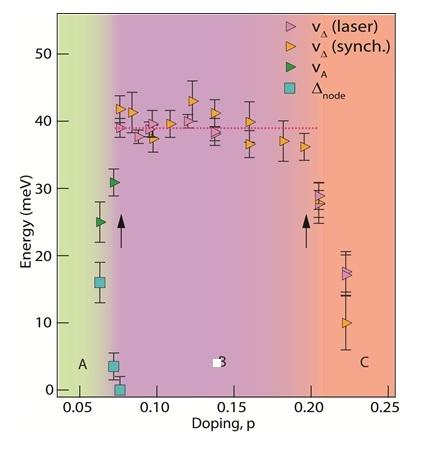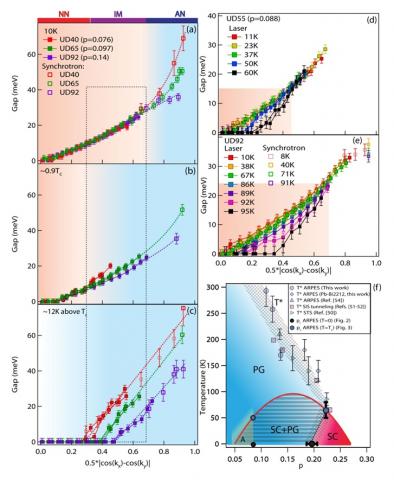
The mechanism of superconductivity in the cuprate high temperature superconductors remains unresolved. One approach to this problem is to understand the phases that exist adjacent to superconductivity on the temperature-doping phase diagram. The pseudogap phase above Tc has been a particular stumbling block because it is not a Fermi liquid as with conventional superconductors. Recently there has been increasing evidence that the pseudogap is a distinct phase from superconductivity that persists below Tc, rather than a precursor to superconductivity. Important contributions to this discovery came from angle-resolved photoemission spectroscopy (ARPES), which observed distinct phenomenology of gaps on different portions of the Fermi surface, implying a picture where superconductivity dominates near the node (along the bond diagonal) and the pseudogap dominates near the antinode (near (π,0)).

In a study recently published in PNAS, researchers at SSRL Beam Line 5-4 and Stanford explored the full doping, temperature, and momentum dependence of spectral gaps in the superconducting state of Bi2Sr2CaCu2O8+δ (Bi-2212) with unprecedented precision and completeness. What emerges is a clear picture of how the gap in the superconducting state sensitively reflects phases which coexist with superconductivity. This study had three components: low-temperature measurements that revealed three distinct ground states at different dopings; temperature-dependence measurements that revealed that superconductivity suppresses the pseudogap in a momentum-dependent manner; and a revised phase diagram motivated by these data that resolved important discrepancies in the literature.
In the superconducting state, the cuprate gap function (Δ(k)) follows a simple d-wave form near the node as a function of momentum: Δ(k)=vΔ*0.5*|cos(kx)-cos(ky)|. In a simple scenario, the prefactor vD measures the superconducting order parameter. The researchers found three distinct doping regimes where vD displays different doping dependencies. For p>0.19, vΔ decreases as Tc decreases; for 0.076<p<0.19, vΔ is perfectly independent of doping and Tc; and for p<0.076, a fully-gapped phase emerges where the near-nodal gap function has the form Δ(k)=Dnode + vA*0.5*|cos(kx)-cos(ky)|. These results are interpreted as follows: the proportional relation between Tc and vD p>0.19 implies a pure superconducting ground state in that doping regime, and the highly anomalous doping-independent vΔ found at 0.076<p<0.19 is identified as the doping regime where pseudogap and superconductivity coexist when T<<Tc, with support from independent spectroscopic measurements. Thus, p=0.19 is identified as the T=0 endpoint of the pseudogap phase. The phase existing p<0.076 is interpreted as a coexistence regime between superconductivity and another phase distinct from the pseudogap, possibly fluctuating spin-density wave order. Finally, Δnode does not appear to have a superconducting origin because it persists above Tc.

In the temperature-dependence portion of the study, researchers focused on the doping regime 0.076<p<0.19 and inferred the origin of gaps at every momentum based on their phenomenology. The pseudogap phase boundary, T*, increases with underdoping, so a momentum region where gaps followed this same doping dependence was identified with the pseudogap. Likewise, a superconducting gap closes at Tc, so momenta where gaps diminished approaching Tc were identified with superconductivity. It was found that the pseudogap is confined to the antinodal region at low temperature, but at temperatures just below Tc, pseudogap-like doping-dependence is observed over a much larger region of the Fermi surface. This indicates that superconductivity suppresses the pseudogap in a momentum-dependent fashion below Tc, pushing it out of a portion of the Fermi surface. Furthermore, it was found that superconductivity dominates a larger portion of the Fermi surface at higher dopings. This implies that at a sufficiently large doping, the pseudogap exists just below Tc, but is suppressed completely by superconductivity at low temperature.
The low-temperature portion of the study revealed the T=0 endpoint of the pseudogap to be at p=0.19, but surprisingly, when measurements were performed above Tc, the pseudogap was still seen at that doping and slightly higher. This discrepancy is not new, as the endpoint of the pseudogap has been debated in the literature for some time. However, the present research reports it within a single technique, ARPES, and offers a solution with a re-entrant psedudogap phase boundary inside the superconducting dome. This phase boundary is anchored at T=0 and T=Tc by ARPES measurements, and it is naturally implied from the phase competition observed between the pseudogap and superconductivity.
1. W. S. Lee et al. Nature 450 81 (2007)
2. K. Tanaka et al. Science 314 1910 (2006)
3. T. Yoshida et al. Phys. Rev. Lett. 103 037004 (2009)
4. M. Hashimoto et al. Nat. Phys. 6 414 (2010)
5. T. Kondo et al. Nature 457 296 (2009)
I. M. Vishik, M Hashimoto, R.-H. He, W. S. Lee, F. Schmitt, D. H. Lu, R. G. Moore, W. Meevasana, T. Sasagawa, S. Uchida, K. Fujita, S. Ishida, M. Ishikado, Y. Yoshida, H. Eisaki, Z. Hussain, T. P. Devereaux, and Z. X. Shen. Phase competition in trisected superconducting dome. PNAS 109 (45) 18332–18337 (2012) doi: 10.1073/pnas.1209471109




